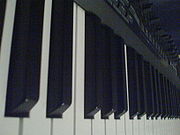
MIDI keyboard
Encyclopedia

Piano
The piano is a musical instrument played by means of a keyboard. It is one of the most popular instruments in the world. Widely used in classical and jazz music for solo performances, ensemble use, chamber music and accompaniment, the piano is also very popular as an aid to composing and rehearsal...
-style user interface keyboard
Musical keyboard
A musical keyboard is the set of adjacent depressible levers or keys on a musical instrument, particularly the piano. Keyboards typically contain keys for playing the twelve notes of the Western musical scale, with a combination of larger, longer keys and smaller, shorter keys that repeats at the...
device used for sending (MIDI) signals
Musical Instrument Digital Interface
MIDI is an industry-standard protocol, first defined in 1982 by Gordon Hall, that enables electronic musical instruments , computers and other electronic equipment to communicate and synchronize with each other...
or commands over a USB or MIDI cable to other devices connected and operating on the same MIDI protocol interface. This could also be a personal computer running software such as a digital audio workstation
Digital audio workstation
A digital audio workstation is an electronic system designed solely or primarily for recording, editing and playing back digital audio. DAWs were originally tape-less, microprocessor-based systems such as the Synclavier and Fairlight CMI...
(DAW) that listens to and sends MIDI information to other MIDI devices connected by cable or running internal to the personal computer system. The basic MIDI keyboard does not produce sound. Instead, MIDI information is sent to an electronic module capable of reproducing an array of digital sounds or samples that resemble traditional analog musical instruments. These samples or waveforms are also referred to as voices or timbres.
Not all MIDI keyboards are based on the piano style user interface. Many MIDI keyboard controllers have pads or buttons that also send MIDI signals, and most pads have a velocity sensing capability so that varying volumes of sound can be played/voiced. Another such keyboard device is the Continuum Fingerboard
Continuum (instrument)
The Continuum Fingerboard or Haken Continuum is a music performance controller developed by Lippold Haken, a professor of Electrical and Computer Engineering at the University of Illinois, and sold by Haken Audio, located in Champaign, Illinois....
which is based on a "fretless" type keyboard interface enabling portamento style note changes at will during play.

In the MIDI protocol
Musical Instrument Digital Interface
MIDI is an industry-standard protocol, first defined in 1982 by Gordon Hall, that enables electronic musical instruments , computers and other electronic equipment to communicate and synchronize with each other...
used in each of these midi controllers, an encoding scheme is used to map a MIDI value to a specific instrument sample. Also, other sound parameters such as note volume (velocity), aftertouch, pitch bend and modulation controls are also included in the MIDI protocol scheme. The keyboard merely acts as a MIDI controller of sound modules and other MIDI devices, including activating sounds by MIDI control within DAW
Digital audio workstation
A digital audio workstation is an electronic system designed solely or primarily for recording, editing and playing back digital audio. DAWs were originally tape-less, microprocessor-based systems such as the Synclavier and Fairlight CMI...
software.
MIDI keyboards are a very common feature of a recording studio, and any DAW setup. Most include a transpose
Transposition (music)
In music transposition refers to the process, or operation, of moving a collection of notes up or down in pitch by a constant interval.For example, one might transpose an entire piece of music into another key...
function and the ability to set different octave
Octave
In music, an octave is the interval between one musical pitch and another with half or double its frequency. The octave relationship is a natural phenomenon that has been referred to as the "basic miracle of music", the use of which is "common in most musical systems"...
s. Many MIDI keyboards have pitch bend and modulation
Modulation
In electronics and telecommunications, modulation is the process of varying one or more properties of a high-frequency periodic waveform, called the carrier signal, with a modulating signal which typically contains information to be transmitted...
wheels. Some also have extra sets of assignable rotary knobs and/or buttons for sending custom MIDI messages to the synthesiser, sampler or DAW software. Devices with extra features (also including rhythm input, instrument selection, transport control) are sometimes called keyboard controllers.
Other features that some MIDI keyboards might include are:
- Input for foot switch (usually used as a sustain pedalSustain pedalA sustain pedal or sustaining pedal is the most commonly used pedal in a modern piano. It is typically the rightmost of two or three pedals. When pressed, the sustain pedal "sustains" all the damped strings on the piano by moving all the dampers away from the strings and allowing them to vibrate...
) - Input for a foot expression controller
- Semi-weighted or fully weighted keys
- Capability of sending aftertouch
- Direct USB connection for use with computers
MIDI keyboards come in a range of sizes, from 25 keys (two octaves) to full 88-key length. MIDI keyboards with fewer than 61 keys tend not to have weighted keys.
External links
- MIDI Keyboard Limits, an interactive animation by Michael Schreiber, The Wolfram Demonstrations Project, 2007.

